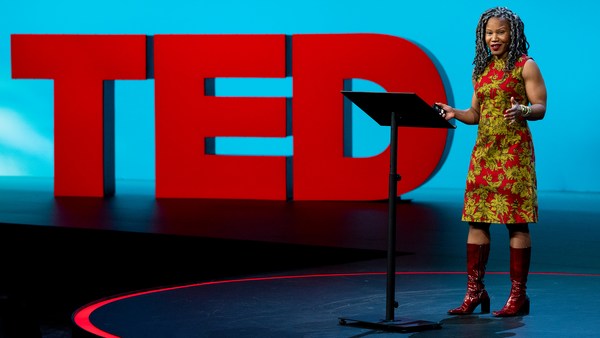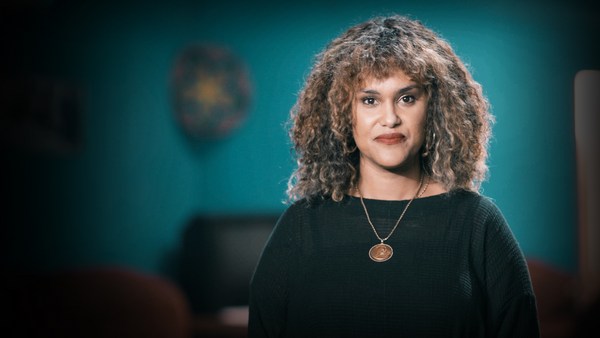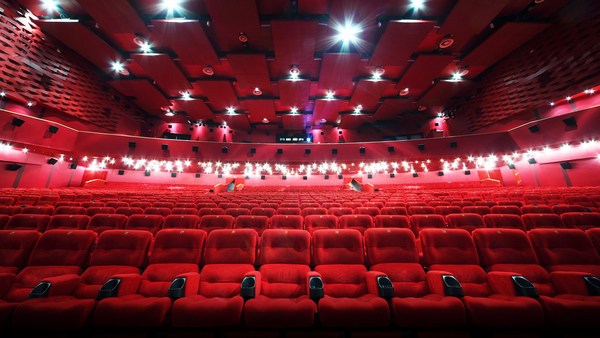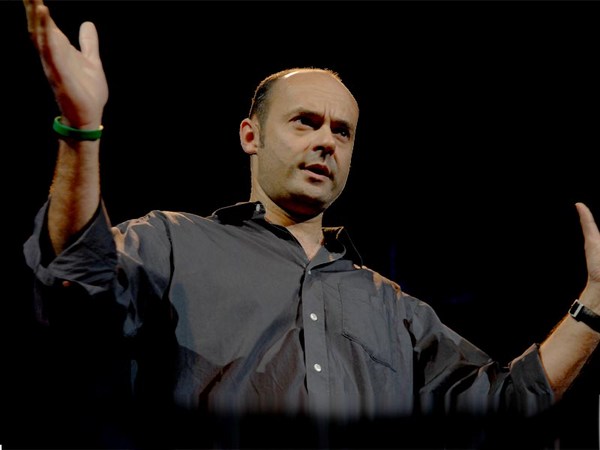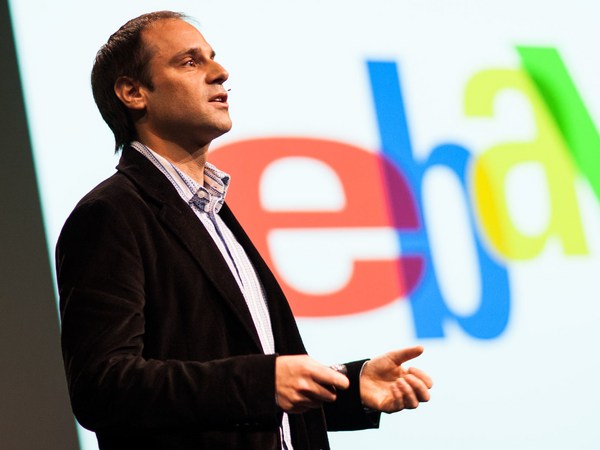Think about your hometown. Think about the place where important things have happened in your life and in the lives of those you love. Now, what if you woke up one day and it was just gone?
My very first film was about a town that disappeared. I was 16 at the time, and my family was on a vacation to see the great national parks of the West. And somewhere in Wyoming we happened upon a classic tourist trap: an old Western ghost town. And admission was five dollars a head, and there were six of us and my dad was frugal. So his idea was send John in alone with the video camera, and the rest of the family will just watch the videotape later. So I ventured in alone and attempted to capture all of the mystery and mystique of this town lost to time.
Now, old Western ghost towns capture our imagination because they are a touchstone to America's pioneer history. But in time I would come to understand that ghost towns still happen. Wildfires rage, earthquakes strike, levees break. But more commonly, it is the insidious, slow-motion disaster. Layoffs at the textile mill. The closing of a steel plant. Or the suburban sprawl that slowly sucks all life out of an old downtown, leaving it in constant decline.
The COVID-19 lockdown turned every city into a temporary ghost town, and we’re still not sure if some communities can emerge from the economic devastation. And it also taught us that the forces that destroy cities are big and complex and out of our control and sometimes impossible to predict.
But there is something that we can do, that we can control, that will help us navigate these challenges. We can develop community resilience. We can build civic pride and a strong identity for our communities that will give us the determination to survive and to succeed or to rebuild, even when rebuilding from ruins. And this is the power of the civic story.
I first learned that a story can change a city from a barber. When I was 24, I set out to make my first real film, a feature documentary about Route 66, once known as the Mother Road and the Main Street of America. And along this road is a tiny town in northern Arizona called Seligman. And in this town is where I met the barber, Angel Delgadillo, and he became one of the narrators in my film.
Now, hundreds of towns along Route 66 became 21st-century ghost towns when they were bypassed by the interstate freeway system. And Angel told me about the day that they opened Interstate 40 across Arizona and bypassed his town of Seligman. Up until that day, hundreds or even thousands of cars would pass by his barber shop window every day. He told me that the minute they open the lanes of I-40, the traffic stopped. And it was as if they had gone to the edge of town and put up a gate and forbidden people to come into town, like somebody had turned off a faucet. For years after this, he sat in his barber chair and stared out at the empty streets and realized Seligman was dying. And he grew bitter, and he grew angry.
And then he realized something important. While Seligman may be off the beaten path, it wasn't obsolete. It had something special. Route 66 was an important part of American history, and Seligman was part of that story. And he had a hunch that if the entire community embraced that heritage, it would lead to a future. So they swept the sidewalks and painted and cleaned up and petitioned the state of Arizona to mark the old road, the route through town, as a historic highway. And it took ten years, but eventually they did it. And the state of Arizona made the stretch from Williams through Seligman to Kingman an official historic Route 66 Highway, and the iconic 66 Highway shield signs returned. And that's when I met him. By then, his barbershop had morphed into a visitor center, and he was selling maps and souvenirs and mugs and fridge magnets and occasionally still giving a shave and a haircut. But mostly he was telling the story of Route 66 and posing for photos. And this story, their story, eventually revived Seligman. And not just Seligman, but dozens of towns, from Chicago to LA, were inspired by Angel and Seligman, and they also embraced their heritage and found a way forward. On a recent trip there, the Seligman visitor center told me they were averaging 160,000-200,000 visitors per year and Angel is still posing for photos 24 hours a day, as a life-sized cutout in his barber shop.
As a filmmaker focused on telling the stories of cities and towns, I've observed something firsthand. Communities that are successful, that are managing to stage a comeback or revitalize after an era of demise are places where people of the towns seem to know their story. They know where they've been and where they're going. Now why is this? Why does story matter?
Well, here's a clue. It comes from a groundbreaking psychological study done by Emory University and the Emory Center for the Study of Myth and Ritual in American Life. And in this study, they determined that the single biggest predictor of a child's emotional strength and health and resilience was story. The more a child knew about their family history, the stronger they were. Somehow, the stories of their ancestors and relatives, how they overcame obstacles and endured hardship, seem to infuse children with confidence and courage and grit. Well, as it turns out, what's true for a child is true for a community.
Tenino, Washington is a small town about 15 miles from my hometown of Olympia, Washington. It’s [has] a population of about 2,000 people. It was founded as a sandstone city. Sandstone from the quarries in Tenino were used to build some of the West Coast’s grandest buildings: churches and libraries and railroad stations. And if you walk Tenino's Main Street today, you'll see many buildings built from this sandstone. As a matter of fact, the city council recently passed a law requiring that any new building in Tenino in the central district must use a certain percentage of sandstone in its construction. And this gives the town a unique look and a physical and visual connection to their own story. I recently traveled to Tenino to create a short film about this community and their connection to their story.
Tenino's toughest time was the Great Depression. The only bank in town closed, and they ran out of money. There was a run on physical currency, and the city leaders at the time decided, well, why don't we just print our own? And they devised a way to print wooden dollars, and they distributed this throughout the community to allow commerce to continue. Fast forward, the year 2020, the COVID pandemic hits, another economic crisis. Well, everybody in Tenino remembered the Great Depression and the wooden dollars, and they thought, why don't we just do it again? The 1870s-era printing press that had printed money back then was still down at the local history museum. So they poured the ink and fired it up and started printing 25-dollar COVID relief funds. And they distributed this to residents. Now, Walmart and Amazon do not accept this. But that’s OK. In fact, that's the point. Tenino businesses do. And so in addition to being a relief program, it is an economic stimulus for the local economy, encouraging people to spend their money at local shops, businesses and restaurants, the ones owned by their family, friends and neighbors. Now, I noticed there was a strange Latin phrase on this money, and I asked the mayor what it meant. And he said, “Loosely translated, it means 'We got this.'" And I thought, there is another example of a community that summoned confidence in the face of a crisis empowered by their civic story.
Now, sometimes we get stuck in a cynical and self-defeating narrative. Welcome to Buffalo, New York. In all fairness, Buffalo has had a bit of a streak of bad luck. Shortly after being founded, we were burned to the ground by the British. The Erie Canal made us one of the richest, most important cities in America. But when shipping was replaced by trains and trucking, we went from indispensable to obsolete. And in the 1950s, a mass exodus began, and we've lost roughly half our population. The great blizzard of '77 made us a constant punchline and punching bag of national comedians. The Christmastime closing of Bethlehem Steel in 1983 and then four straight Super Bowl losses in the 1990s. I won’t go into the details, just Google: “wide right.” By the time I arrived in Buffalo in 2005, you really can't blame people here for feeling like, "You know, we're just never going to win." Matter of fact, I remember my first trip to Coles, a beloved neighborhood bar. I told some of the local folks that I had just moved here from the Seattle area. And instead of saying, “Welcome to our city,” they said, "What happened? Did you lose a bet?"
This was Buffalo then, a city walking through life with a "kick me" sign on its back. And since making Buffalo home, I have made several short films that, along with other artists and authors and photographers and bloggers, have helped to change the conversation. In particular, the film "Buffalo: America's Best Designed City," helped to reframe things. The film tells the story of why Frederick Law Olmsted, once called Buffalo "the best planned city in America, if not the world." And then it tells how he went on to design and build the first and best park system in America right here. It then honestly recounts how we squandered that legacy by making a series of mistakes that did severe damage to the city and to our neighborhoods. But in the final act, it tells the story of how today's generation is rediscovering and embracing Buffalo's exquisite urban design and the historic neighborhoods, and are committing themselves to the long and difficult task of fixing and restoring it.
If the old story in Buffalo was “we’re unlucky,” the new story is "we'll make our own luck." If the old story was "we're doomed," the new story is "we're destined."
I think one of my favorite things about Buffalo is that it is a city with a true narrative arc. I mean, we've got highs and lows and wins and losses and setbacks and comebacks. And I think it is this narrative arc and our deep connection to it that is our city's secret weapon and strange appeal. I mean, to be in Buffalo is to live in a city that has embarked on the hero's journey.
What about your town? Has it set foot on that journey? I hate to say it, but I think one of the biggest threats to our cities is our own apathy. In too many places we have given up or given in or grown to accept things the way they are. A well-told civic story can be the spark that rekindles love for our place. It can be the spark that rekindles our pride. The civic story, as we have learned, is not just about history. It's also about the future, about what our cities are becoming. And that's the story that we live and participate in every day.
I’m a filmmaker, and I love to tell the civic story of a place through the medium which I consider the modern-day campfire, that flickering light in the dark that can gather a hushed crowd to experience something together. But there are many ways to tell the civic story, no matter your skill set. Do you like to talk to people? Start a podcast series. Do you write or take photos? Create a book or a calendar that chronicles the life and times of your town. Fight to preserve an important building. Make a musical album or a mural. You could collect city memorabilia and use it to decorate your walls and your shelves and your bicycles and bumpers and computers and phone cases. All of these are ways to learn and share the civic story.
So think about your place. Where are you from? Does it have a past worth remembering? Does it have a future worth hoping for? If so, a story can change a city.
Thank you.
(Applause)
